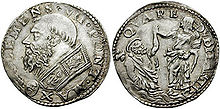Benvenuto Cellini
His best-known extant works include the Cellini Salt Cellar, the sculpture of Perseus with the Head of Medusa, and his autobiography, which has been described as "one of the most important documents of the 16th century".Another celebrated work from Rome is the gold medallion of "Leda and the Swan" executed for the Gonfaloniere Gabbriello Cesarino, and which is now in the Museo Nazionale del Bargello in Florence.There he once again took up his skills as a goldsmith, and was warmly welcomed by Duke Cosimo I de' Medici – who elevated him to the position of court sculptor and gave him an elegant house in Via del Rosario (where Cellini built a foundry), with an annual salary of two hundred scudi.In 1548, Cellini was accused by a woman named Margherita of having committed sodomy with her son Vincenzo,[18] and he temporarily fled to seek shelter in Venice.[22] During the war with Siena in 1554, Cellini was appointed to strengthen the defences of his native city, and, though rather shabbily treated by his ducal patrons, he continued to gain the admiration of his fellow citizens by the magnificent works which he produced.He was also named a member (Accademico) of the prestigious Accademia delle Arti del Disegno of Florence, founded by the Duke Cosimo I de' Medici, on 13 January 1563, under the influence of the architect Giorgio Vasari.Only the bronze tympanum of this unfinished work, which represents the Nymph of Fontainebleau (Paris, Louvre), still exists, but the complete aspect can be known through archives, preparatory drawings and reduced casts.His most distinguished sculpture is the bronze group of Perseus with the Head of Medusa, a work (first suggested by Duke Cosimo I de Medici) now in the Loggia dei Lanzi at Florence, his attempt to surpass Michelangelo's David and Donatello's Judith and Holofernes.[12] In addition to the bronze statue of Perseus and the medallions previously referred to, the works of art in existence today are a medallion of Clement VII commemorating the peace between the Christian princes, 1530, with a bust of the pope on the reverse and a figure of Peace setting fire to a heap of arms in front of the temple of Janus, signed with the artist's name; a signed portrait medal of Francis; a medal of Cardinal Pietro Bembo;[12] and the celebrated gold, enamel and ivory [citation needed] salt cellar (known as Saliera) made for Francis I of France at Vienna.Its principal figures are a naked sea god and a woman, sitting opposite each other with legs entwined, symbolically representing the planet Earth.The important works which have perished include the uncompleted chalice intended for Clement VII; a gold cover for a prayer book as a gift from Pope Paul III to Charles V, Holy Roman Emperor, both described at length in his autobiography; large silver statues of Jupiter, Vulcan and Mars, created for Francis I during his stay in Paris; a bust of Julius Caesar; and a silver cup for the cardinal of Ferrara.In the print room of the British Museum are three watercolour drawings of this splendid morse by F. Bertoli, done at the insistence of an Englishman named Talman in the first half of the 18th century.The obverse and reverse, as well as the rim, are drawn full size, and moreover the morse with the precious stones set therein, including a diamond then considered the second-largest in the world, is fully described.He writes of his time in Paris: When certain decisions of the court were sent me by those lawyers, and I perceived that my cause had been unjustly lost, I had recourse for my defence to a great dagger I carried; for I have always taken pleasure in keeping fine weapons.Then I sought out the other fellow who had brought the suit, and used him also such wise that he dropped it.Parts of his tale recount some extraordinary events and phenomena; such as his stories of conjuring up a legion of devils in the Colosseum, after one of his mistresses had been spirited away from him by her mother; of the marvellous halo of light which he found surrounding his head[34] at dawn and twilight after his Roman imprisonment, and his supernatural visions and angelic protection during that adversity; and of his being poisoned on two separate occasions.






Benvenuto Cellini (opera)Cellini (disambiguation)FlorenceRepublic of FlorenceGrand Duchy of TuscanySantissima Annunziata, FlorenceAccademia delle Arti del DisegnoGoldsmithCellini Salt CellarMannerismPerseus with the Head of MedusaMarconeaffraypolymathBolognacornettTorrigianocasketcandlesticksbishop of SalamancaPope Clement VIILeda and the SwanMuseo Nazionale del BargelloCharles V, Holy Roman EmperorCharles III, Duke of BourbonConstable of FrancepontiffPhilibert of Châlon, prince of OrangeSack of RomeHerculesFrancis I of FranceMantuapapal mintarquebusierblood revengeNaplesnotarycardinalsPaul IIIinterregnumPier Luigi FarneseVeniceCastel Sant'Angeloscaffolddiamond dustFerraraFrancis IFontainebleauDuchesse d'ÉtampessodomyBaccio BandinelliMedicisCosimoBandinelliCosimo I de' MediciGiorgio VasariSantissima AnnunziataChâteau de FontainebleauNymph of FontainebleauLouvrebronzeCosimo I de MediciLoggia dei LanziMichelangeloDonatelloJudith and HolofernesAndromedaBargelloLoggiaUffiziEl EscorialJupiterBindo AltovitiSalieraPerseusClement VIIPietro BemboViennaKunsthistorisches MuseumKunstkammercrucifixmarbleMediciEscorial MonasteryMadridcrown of thornsAlessandro de MediciPhineusportraitchalicePope Paul IIIVulcanJulius Caesarcardinal of FerraraPope Pius VINapoleon IPapal StatesBritish MuseumwatercolourLouvre MuseumNational Gallery of Artone criticColosseumThomas RoscoeJohn Addington SymondsRenaissancePortraits of Benvenuto CelliniAlexandre Dumas, pèrePaul MeuriceLouis GalletlibrettoCamille Saint-SaënsAscanioBalzacLa Peau de chagrineponymous operaHector BerliozFranz LachnerBroadwayThe Firebrand of FlorenceIra GershwinKurt WeillThe Affairs of CelliniGregory La CavaFrank MorganConstance Bennett

